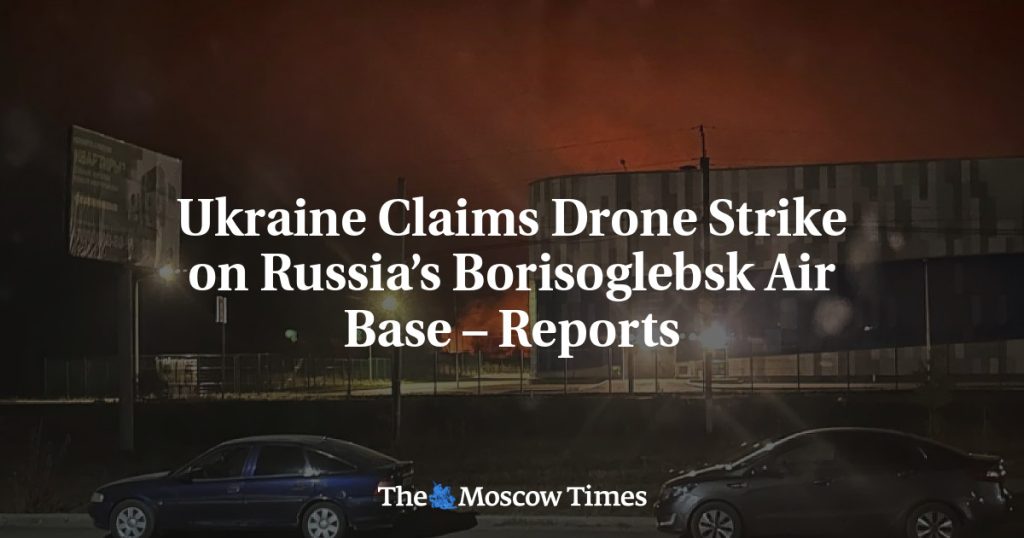Ukrainian drones targeted the Borisoglebsk aviation center in Russia’s Voronezh region, reportedly striking a base that housed guided aerial bombs, Su-35 and Su-34 fighter jets, and aviation fuel. The attack was said to be in response to Russia bombing Ukrainian territories with guided aerial bombs from this location. Borisoglebsk is located approximately 300 kilometers from the Ukrainian border and over 400 kilometers south of Moscow. NASA satellite monitoring confirmed active fires in Borisoglebsk, including at the air base, indicating the success of the Ukrainian drone strike. The Russian Defense Ministry claimed to have intercepted or destroyed 113 Ukrainian drones in several regions, with 25 drones intercepted over Voronezh.
The Borisoglebsk aviation center and the nearby Chkalov aviation training center have been targeted in previous attacks in August and April, suggesting a pattern of Ukrainian strikes on these strategic military locations in Russia. The ongoing conflict between Ukraine and Russia continues to escalate, with each side engaging in aerial attacks on key military installations. The use of drones in these attacks indicates a shift towards modern warfare tactics, where unmanned aerial vehicles are being utilized to target enemy assets. The heightened tensions between the two countries have resulted in increased military activity and retaliation, leading to a cycle of violence and destruction.
The significance of the Borisoglebsk aviation center being targeted lies in the strategic importance of the base and its role in Russian military operations. By striking a facility that houses fighter jets, guided bombs, and aviation fuel, Ukraine aims to disrupt Russian air capabilities and deter further attacks on Ukrainian territories. The successful drone strike on Borisoglebsk demonstrates Ukraine’s ability to launch precision attacks on high-value targets deep within Russian territory, showcasing their military capabilities and resolve in the face of Russian aggression. The use of anonymous security service sources to report on the drone strike highlights the covert nature of the attack and the need for secrecy in carrying out such operations.
Russia’s Defense Ministry’s claim of intercepting or destroying 113 Ukrainian drones signifies the intensity of the conflict and the extent of drone activity in the region. The Russian military’s efforts to counter the Ukrainian drone attacks demonstrate their commitment to defending their airspace and military installations from aerial threats. The use of drones in modern warfare has become increasingly prevalent, allowing for targeted strikes on enemy positions with reduced risk to personnel. The back-and-forth drone engagements between Ukraine and Russia reflect the evolving nature of warfare and the reliance on unmanned aerial vehicles for both offensive and defensive operations.
The technological aspect of the drone attacks, coupled with the geographical distance between Ukraine and Russia, highlights the complexities of modern warfare in the digital age. The ability to conduct precision strikes on targets hundreds of kilometers away underscores the advancements in military technology and the increasing reliance on unmanned systems for intelligence gathering and combat operations. The use of satellite monitoring to confirm the effects of the drone strike on Borisoglebsk showcases the role of surveillance in modern conflicts and the importance of real-time information for strategic decision-making. The escalation of drone warfare between Ukraine and Russia raises concerns about the broader implications of unmanned aerial attacks and the potential for further destabilization in the region.
In conclusion, the recent Ukrainian drone strike on the Borisoglebsk aviation center in Russia’s Voronezh region is a significant development in the ongoing conflict between Ukraine and Russia. The targeted attack on a key military installation indicates Ukraine’s willingness to engage in strategic operations deep within Russian territory, using modern warfare tactics to disrupt enemy capabilities. The Russian Defense Ministry’s response to the drone attacks underscores the intensity of the conflict and the importance of air defense measures in countering aerial threats. The evolving nature of warfare, with a focus on unmanned aerial vehicles and precision strikes, highlights the challenges and opportunities presented by modern military technology. The continued drone engagements between Ukraine and Russia signal a dangerous escalation in hostilities, with implications for regional security and stability.


